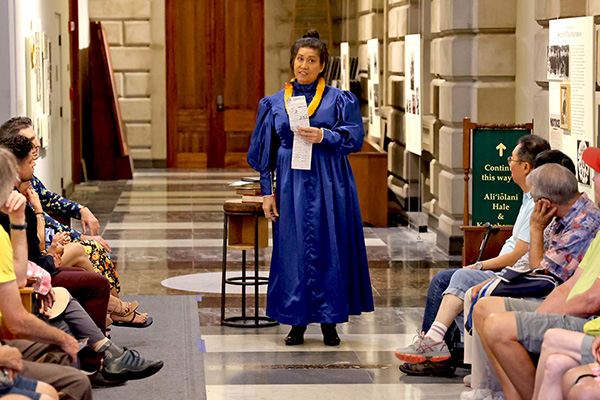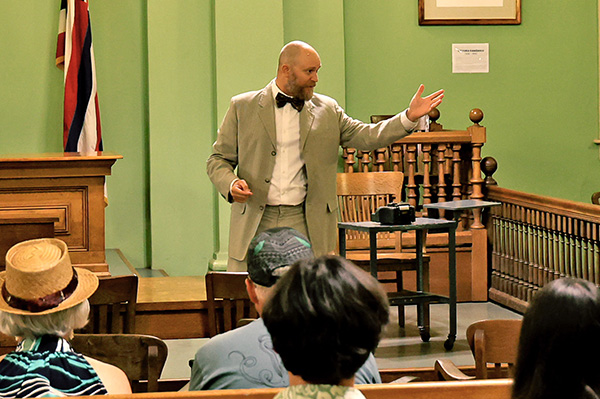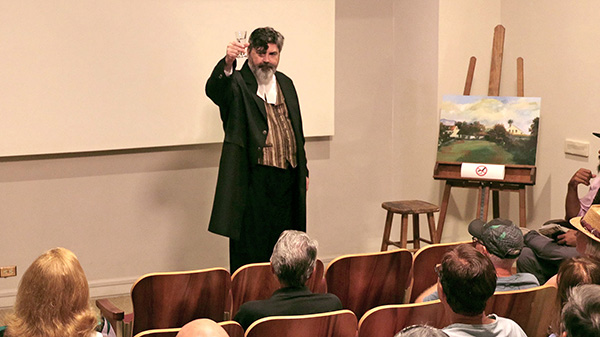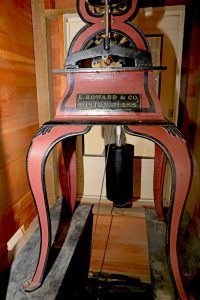150 Years of Aliʻiōlani Hale Celebrated with Historical Re-Enactment Tours
Posted on May 3, 2024 in Featured News, News & Reports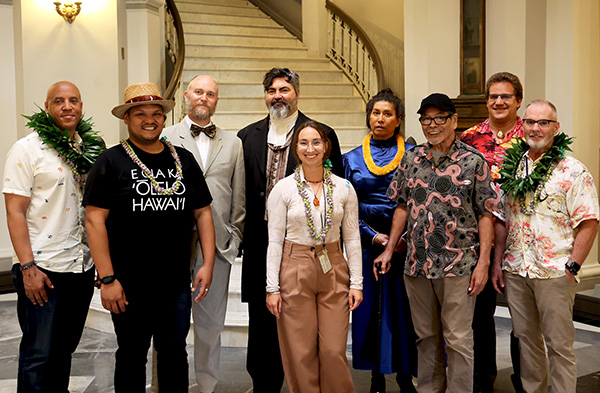
Members of the King Kamehameha V Judiciary History Center (JHC) and Hawaiian Mission Houses’ History Theatre (HMHHT) combined talents and resources for the commemorative “Ke Kūkulu Kānāwai: Celebrating 150 Years of Law, Civics, and Culture at Aliʻiōlani Hale” on April 27, 2024. From left: JHC Education Director Keahe Davis, JHC Hawaiian Language Education Specialist Ahukini Fuertes, HMHHT actor Christopher Denton, HMHHT actor Kevin Keaveney, JHC Curator of Collections & Programs Brieanah K. Gouveia, HMHHT actor Kahana Ho, HMHHT Director Will Haʻo, HMHHT Director of Education Michael Smola, and JHC Executive Director Matt Mattice.
More than 200 people attended a special community celebration on Saturday, April 27, commemorating the sesquicentennial (150th) anniversary of the construction of Aliʻiōlani Hale, home of the Hawaiʻi Supreme Court.*
Actors from the Hawaiian Mission Houses’ History Theatre (HMHHT), in period costume and character, engaged with guests, bringing to life “personal accounts” of notable historical events from before, during, and after the building’s construction.
Kahana Ho portrayed Emma M.B. Nakuina (1847-1929), curator of Hawaiʻi’s National Museum, which was located in Aliʻiōlani Hale. She was the first woman to hold the title of Water Commissioner, serving from 1892 to 1907.
Christopher Denton portrayed William C. Parke (1821-1889), marshal of the Hawaiian Kingdom, who for 34 years served as the chief law enforcement officer under five Hawaiian monarchs.
Kevin Keaveney portrayed Rev. William Richards (1793-1847), an American Board of Commissioners for Foreign Missions (ABCFM) missionary whose teachings helped Mōʻī Kamehameha III and Kuhina Nui Kekāuluohi draft the Kingdom of Hawaiʻi’s 1839 Declaration of Rights and the Kingdom’s Constitution of 1840.
The event was also the opening of the Judiciary History Center’s new art exhibition, ʻImi i Ka Pono: Reflections on Land, Culture, and Identity. This is the Center’s first collaboration with the Hawaiʻi State Foundation on Culture and the Arts. The exhibit creates an artistic narrative that explores themes of environment, immigration, ethnicity, culture, and public policy, providing portals into different perspectives across Hawaiʻi’s diverse communities.
With more than 20 pieces from the Foundation’s Art in Public Places Collection, many of which have never before been shown together, visitors are invited to reflect on the pursuit of justice in Hawaiʻi and its legacy today.
ʻImi i Ka Pono: Reflections on Land, Culture, and Identity is a free exhibition available to the public at the King Kamehameha V Judiciary History Center, on the first floor of Aliʻiōlani Hale, 8:45 a.m. – 4:30 p.m., Monday to Friday, until July 26, 2024. For more information visit:
https://mailchi.mp/jhchawaii/150-anniversary-event-1
* The Interesting History of Aliʻiōlani Hale
Construction
• The building was constructed using plans originally intended for a palace. When King Kamehameha V determined the growing kingdom had greater need of government offices, he commissioned the construction using these plans for the new administrative facility to help maintain costs.
• King Kamehameha V laid the cornerstone on February 19, 1872. He was one of the first Masons in Hawai‘i and used a Masonic ceremony for the laying of the cornerstone and placement of a time capsule.
• The building was completed 150 years ago in April 1874, when it was dedicated by King David Kalākaua.
• The King Kamehameha I statue was not part of the original construction. It was installed February 14, 1883.
Clock Tower
• The clock tower – at four stories high – was one of the tallest structures in Honolulu at the time.
• The clock itself, with its four six-foot dials in each face of the central tower, was installed by Honolulu’s clock expert, S.K. Rawson. It was manufactured by Howard & Co. of Boston, Massachusetts, for more than $400.
Building Renamed / Newspaper Criticisms
• On May 2, 1874, by command of King Kalākaua, the new government building was renamed Ali‘iōlani Hale, meaning “House of Heavenly Kings” in honor of Kamehameha V, during whose reign the building had been planned and started.
• At the time, Hawaiʻi’s Pacific Commercial Advertiser newspaper criticized “the poorly selected site,” and the building, which they considered “a huge sin and blunder,” of an extravagantly large scale and “ridiculously out of proportion with any possible requirements.” The Hawaiian Gazette newspaper wrote that it might make a fine palace as originally designed.
Opening, 1874 Legislature / More Newspaper Criticisms
• The first official use of Aliʻiōlani Hale was on the opening day of the Legislature, April 30, 1874.
• Thereafter, the newspapers continued to criticize the site and the large building for being too grand for its purpose and again suggested it be converted to a palace. In June 1874, Hawaiʻi’s trade winds apparently over-ventilated the new government building and the Pacific Commercial Advertiser wrote: “…especially the upper story is full of currents of air, rushing about in every direction, whenever there is a breeze outside. As a consequence, everybody about the building has a chronic cold of more or less severity.”
Artists
• Artists who traveled to Hawaiʻi, including Charles Furneaux, Joseph D. Strong, and Jules Tavernier, were allowed by King Kalākaua to use the airy “Tower Studio” (the small room below the clock tower) to paint and exhibit their works. Their paintings depicted Hawaiian scenes like the eruption of Mauna Loa in 1880-81 and Japanese laborers at Sprecklesville Plantation.
Seat of Government / Committee of Safety / Provisional Government / Republic of Hawaiʻi
• Aliʻiōlani Hale served as the seat of government of the Kingdom of Hawaiʻi and the Republic of Hawaiʻi.
• In 1893, the Committee of Safety, under the leadership of Lorrin A. Thurston, operated out of Aliʻiōlani Hale where they deposed Queen Liliʻuokalani by public proclamation.
• After the establishment of the Hawaiian provisional government in 1893 and the Republic of Hawaiʻi in 1894, some of the offices in Aliʻiōlani Hale were moved to ʻIolani Palace, including the Hawaiʻi Legislature. Aliʻiolani Hale became primarily a judicial building.
State Courts
In addition to the Hawai‘i Supreme Court, from the 1900s to the early 1980s, courtrooms of the First Circuit (Oʻahu) operated out of Aliʻiōlani Hale, with the clerk of circuit court office, jury rooms, and witness rooms by the 1910s.
National Registers of Historic Places
• A century after the cornerstone was laid, Ali‘iōlani Hale was added to the Hawai‘i State and National Registers of Historic Places in 1972.
Today
• Today, the building serves as the administrative headquarters of the State Judiciary, and houses the Hawai‘i Supreme Court.
• The King Kamehameha V Judiciary History Center, which features a museum that provides public exhibits and programs related to Hawai‘i’s legal history, is located on the first floor.
• On October 20, 2022, the Historic Hawai‘i Foundation held its 48th annual Preservation Honor Awards Ceremony and Reception, where it recognized the sesquicentennial anniversary of Ali‘iōlani Hale (150 years since the laying of the cornerstone and commencement of construction) and its significant contributions to the heritage of Hawai‘i.

